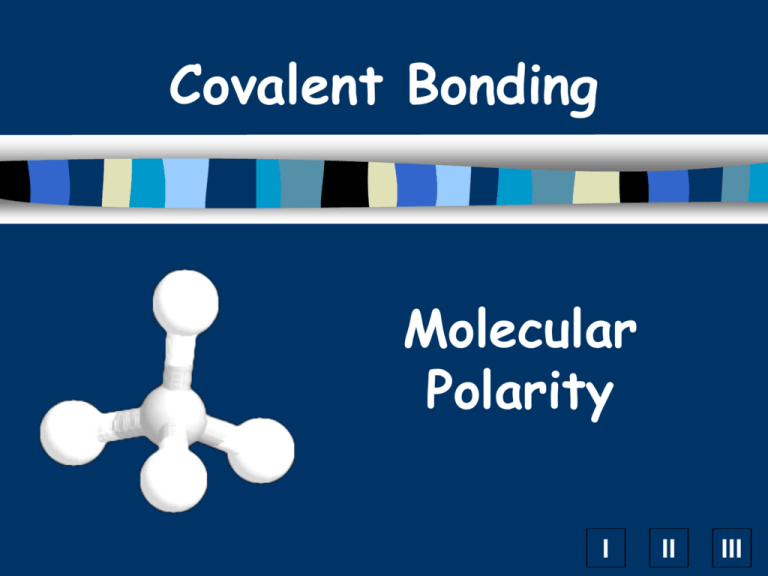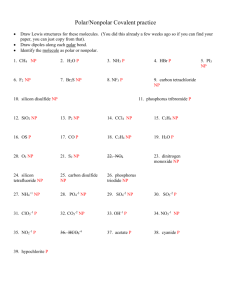polarity powerpoint
advertisement

Covalent Bonding Molecular Polarity I II III Covalent Bonds involve sharing electrons But Just like in real life, not all sharing Is equal !!! / Electronegativity Electronegativity is the ability of an atom to Attract electrons to itself in a covalent bond Large Electronegavity Small Electronegativity So, the atoms in a covalent bond are engaged in a tug-of-war over electrons electrons Results of Tug of War The atom that “wins” will be the one that is more electronegative. Because this atom gets the electrons more of the time, it becomes slightly negative The atom that “loses” becomes slightly positive The Periodic Table allows us To predict differences in F is the most electronegavity electronegative A. Dipole Moment Means the direction of the polar bond in a molecule. Arrow points toward the more electronegative atom. (The direction the electrons will flow + H Cl B. Determining Molecular Polarity Depends on: Electronegativity differences dipole moments molecular shape B. Determining Molecular Polarity Polar Molecules Dipole moments are asymmetrical and don’t cancel . O H2O H H net dipole moment B. Determining Molecular Polarity Nonpolar Molecules Dipole moments are symmetrical and cancel out. F BF3 B F F B. Determining Molecular Polarity Therefore, polar molecules have... asymmetrical shape (lone pairs) or asymmetrical atoms H CHCl3 Cl Cl Cl net dipole moment Linear molecules can be nonpolar . . . Example: CO2 What makes the difference? Or Nonpolar. No Net Dipole Moment Example: HCN Net Dipole Moment Towards N Trigonal Planar molecules are usually nonpolar Example: BF3 But, what makes this one polar? Example: BF2Cl Trigonal Pyramidal Molecules are Polar. Example: NH3 Net Dipole Toward N Tetrahedral Molecules can be polar Example: CH3F Or non polar Example: CF4 Explain this! Can a Molecule be Both Polar and NonPolar? Trigonal planar with Asymmetric atoms Tetrahedral with symmetric atoms Non Polar End Polar End So, polarity can be more of a spectrum than a black and white determination Polar------------------------------------------------------nonpolar More Nonpolar Molecules •Share electrons the “best” •Have the closest electronegativities (or smallest differences) •Have lower boiling and melting points •. . .so More likely to be gases at room temperature •Like dissolves like . . . • Use a nonpolar solvent to dissolve a nonpolar solute More Polar Molecules •Do not share well at all! •Their electronegativity differences are great •Are more like ionic compounds •Have higher melting and boiling points •Most likely to be liquids at room temperature •Like dissolves like . . . •Use a polar/ionic solvent to dissolve a polar/ionic solute Ionic, Polar, Nonpolar: A Continuum Ionic------------ ------------Polar--------- -------Nonpolar Electrons transferred E- shared unequally Huge charge separation E- shared no charge sep. some charge sep. High mp/bp Solids at STP Low mp/bp Liquids at STP Gas at STP




